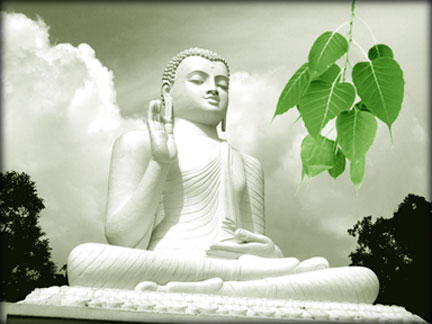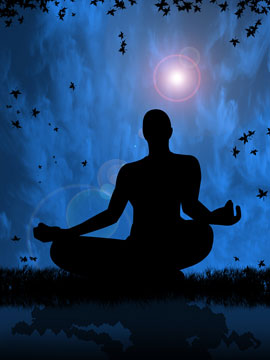|
Duruthu Full Moon Poya falls on Wednesday:
Mindfulness in practice: Loosening the knots of anger
By Lionel Wijesiri
Once upon a time, there was a little boy with a bad temper. His
father gave him a bag of nails and told him that every time he lost his
temper, he should hammer a nail in the fence. The first day the boy had
driven 37 nails into the fence. However, gradually, the number of daily
nails hammered dwindled. He discovered it was easier to hold his temper
than to drive those nails into the fence.
 |
|
The Buddha was the greatest spiritual
mentor in history, who taught boundless compassion and mercy
for all beings. He taught us to guard against anger erupting
in body, speech and mind. |
Finally, the first day came when the boy didn’t lose his temper at
all. He proudly told his father about it and the father suggested that
the boy now pull out one nail for each day that he could hold his
temper. The days passed and the young boy finally told his father that
all the nails were gone. The father took his son by the hand and led him
to the fence.
“You have done well, my son, but look at the holes in the fence. The
fence will never be the same. When you say things in anger, they leave a
scar just like this. You can put a knife in a man and draw it out, it
won’t matter how many times you say, I am sorry, the wound will still be
there.”
This story was related to me by one of my primary school teachers
over five decades ago. It flashed across my mind recently while
listening to a personal experience of one of my young subordinates in
the office.
“Last night, I once again lost my temper with my wife,” he started.
“We were discussing the sharing of duties around the home and within a
few minutes, I got a feeling that my wife was criticising me for not
being able to share her burdens. That sounds glib, but in reality, that
is how I felt. The discussion turned to an argument and then all of a
sudden, I lost my temper. I screamed and exploded and ran out of the
room. Much later, I apologised to her. Yet, the damage was done. This is
not the first time it happened. I am making my loved ones’ lives
miserable.”
Akusala-mula
Anger. Rage. Fury. Frenzy. Wrath. Whatever name you call it, it
occurs to all of us, including Buddhists. However much we value Metta,
loving kindness, Buddhists are also human beings, and sometimes we get
angry.
What does the Buddha teach about anger?
Anger (Dosa) is one of the three Akusala-mula (unwholesome roots).
The term is defined as consisting of Lobha, Dosa and Moha. The
Akusala-mula are the primary causes of the cycle of Samsara and rebirth.
Therefore, purifying ourselves of Akusala-mula is essential to
Buddhist practice.
Anger is an internal formation, and since it makes us suffer, we must
try our best to get rid of it. Psychologists like the expression
“getting it out of your system.” And they speak about “venting” anger.
Some psychologists say that when the energy of anger arises in you,
you should ventilate it by hitting a pillow, kicking something, or by
going into the forest to yell and shout.
 |
|
When you meditate, you’ll become more
aware of your emotional reactions. |
People who use venting techniques such as hitting a pillow or
shouting are actually rehearsing anger. When someone is angry and vents
his anger by hitting a pillow, he is learning a dangerous habit. They
are training in aggression. Instead, our approach should be to generate
the energy of mindfulness and embrace anger every time it manifests.
Mindfulness
Mindfulness (Sati) helps us free ourselves from habitual patterns of
anger. By developing mindfulness, we learn to take responsibility for
our own thoughts and emotional reactions, where we can begin to stop
blaming other people or situations for how we feel. Most of us know what
mindfulness is. It is the presence of mind, awareness, knowing clearly
what is happening right at the very moment of occurrence.
At some point, we all project or externalise our angry thoughts. You
know the scenario. “I am angry because he (she) did/said this/that.” Or
“He (she) did not do what I wanted.” Or “I worked really hard, but the
boss overlooked me for promotion.” There can be thousands of reasons.
There is no denying that each of these situations will cause pain and
life does produce some harsh conditions for us to face. Anger is a form
of suffering, which we often continually reproduce, by our thoughts
around a painful event. Many events will produce pain and it’s perfectly
understandable that we will get angry when certain things happen, but it
is important to understand that you are in control of your thoughts.
Thus, the moment anger arises, we must apply mindfulness. We must
quickly take awareness of the arising of anger. We must note,
acknowledge or say mentally to ourselves: “Ah! There is anger in me.
Anger is arising in me.”
Noting thus, the anger is spotted and its presence acknowledged. Just
this mere act of knowing is helpful in checking the anger. Whenever
anger arises, it usually overwhelms us even before we know it! It clouds
our mind and impairs our judgement.
Our facial expression changes and we begin to snap, gesticulate or
even yell at somebody. When we ‘let rip’ and vent our anger externally
(to a person or object), we are just creating more of what we don’t want
by restricting our resolution with our outburst!
Sadly, disease and a lack of well-being are more likely to occur in
our lives.
Mindfulness checks all this. It prevents the anger from overwhelming
us. It institutes a much needed presence of mind. Instead of responding
or reacting to the anger, we will be watching it. We’ll be watching the
hot feeling, the emotion.
 |
|
Caring for those you
love |
Our next step is to be patient with our anger which really means to
be tolerant of our emotions. It gives us time to reflect and decide on a
wise course of action. In that pause, we have an opportunity to exercise
what the Buddha often emphasised as Yoniso manasikara, which is wise
reflection or proper consideration. In the course of reflection, our
anger will naturally weaken further, and as we become more and more
convinced of the undesirability of anger, the anger will further subside
and finally fade off. That’s the magic of mindfulness – it can promptly
knock out an unwholesome state of mind.
When we exercise Yoniso manasikara, we are not paying attention to
the person, object or condition that is causing us anger.
Instead, we are looking inward at our own state of mind, at the
presence of the feeling or emotion of anger. Logically, when our focus
of attention shifts from the object (cause of our anger) to the pure
awareness of anger itself, as an emotion, anger will fizzle out.
And the beauty of it is that the tapering off of the anger comes
about without any suppression or force. You need not grit your teeth,
clench your fist or use sheer mental force to overcome the anger.
With mindfulness you are examining yourself to build self-awareness
and defuse self-destruction. Mindfulness actually works because you
become an observer of your emotions and this helps you make choices
about how you are going to think, act or express yourself. |

